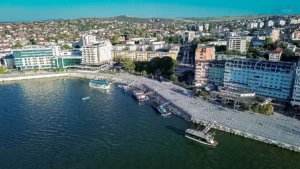
Garganey

Description and how to observe Garganey:
The Garganey is a small-sized species with a distinctive plumage that makes it easy to identify. Males have a prominent white stripe running across their head, contrasting with dark brown and grey sides and back. Females, although more inconspicuous, are recognisable by their brownish spotted pattern.
In the Danube Delta, this species can best be observed in wetlands with dense vegetation, especially in spring and autumn, when it migrates seasonally. It is recommended to use binoculars and to be discreet, as the ducks are wary and may be frightened by human presence.
What it feeds on Garganey:
Garganeys are omnivorous, feeding mainly on aquatic plants, seeds and small invertebrates such as insects and molluscs. In the Danube Delta, they frequently feed in shallow waters, where they forage both by diving and on the surface. Their diet helps maintain the balance of the aquatic ecosystem, controlling insect populations and spreading the seeds of aquatic plants.
Threats:
Garganeys face many threats, the most serious of which are habitat destruction, water pollution and illegal hunting. Changes in wetland structure caused by human activities reduce their access to nesting and feeding sites. As water quality declines, insects and aquatic vegetation, the main source of food, become increasingly scarce, affecting the region's moor duck population.
Ecological role:
More information about Anas querquedula:
- Conservation status: According to the International Union for Conservation of Nature (IUCN), the Muscovy duck is considered a species of low concern, but increasing threats could change this status in the future.
- Migration period: Spring and autumn, when birds migrate between Africa and Europe.
- Vocalisation: Males produce a distinctive "cackling" sound, hence the species name.
Watching the Muscovy Duck in the Danube Delta offers an exciting insight into Romania's wildlife and unspoilt natural beauty. Conserving this species is essential for ecological balance and for the enjoyment of future generations of nature lovers.
Discover now the most beautiful places in the Danube Delta!
In the following pages, you will find detailed information about:
- Top tourist destinations: Traditional villages, nature reserves, tourist trails and much more.
- Activities and attractions: Everything you need to know about boating, fishing, bird watching, cycling and other activities.
- Accommodation and catering: Accommodation to suit all budgets and restaurants serving traditional cuisine.




